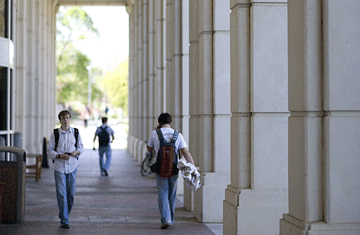
Students at the David W. Mullins Library building on the campus of the University of Arkansas.
College rankings are dead! Long live college rankings! At a meeting of the country's leading liberal arts schools this week in Annapolis, Md., a majority of the 80 or so college presidents in attendance said they would no longer participate in the popular annual rankings conducted by U.S. News and World Report. Instead, the Annapolis Group announced it will help develop an alternative set of data to aid students and their families in the bewildering quest to figure out how one school differs from the next.
College presidents have long been critical of the U.S News rankings, in part because 25% of a school's score is based on a survey filled in by roughly half of college presidents and other top administrators, who rate schools based on reputation but often only selectively, leaving most of the list blank and unjudged. The peer survey strikes many in higher education as silly. But they believe the rankings have an additional and more nefarious component. Several college presidents have publicly complained that the rankings' emphasis on the average SAT scores of incoming freshmen has led colleges to fight over high-achieving (and often wealthy) students by offering them merit scholarships and thus leaving fewer financial-aid dollars available to low-income students.
But now the Annapolis Group, whose 124 members take up most of the slots in U.S News's list of the top 100 liberal arts schools, is putting its collective weight behind a web-based alternative to the rankings that is being spearheaded by the 900-member National Association of Independent Colleges and Universities. NAICU's easy-to-read template, which is expected to be rolled out by hundreds of schools in September, allows students and their families to pull up extensive information organized in an objective format that includes such data as what percentage of students graduate in four years compared to those who graduate in five or six years. It plans to provide a level of detail that is not included in the U.S News rankings, but that could be very important to parents' checkbooks. The NAICU template also lists the four most common majors at each school and gives a complete breakdown on class sizes, revealing how many classes have fewer than 20 students, fewer than 40, fewer than 100 or more than 100.
NAICU is trying to provide a more complete picture than U.S News, and the new format doesn't gloss over unpleasant details. For example, it will list a school's current tuition alongside the sticker price from each of the previous four years (Parents, get ready to watch those bar charts keep climbing upwards over time!). It will also include the percentage of students who receive financial aid as well as what the average net tuition is for financial aid recipients.
The new set of ratings also contains links to such sought-after details as a school's campus safety report, internship and career-placement services and information about how many of its graduates go on to grad school or are employed in the field of their choice within a certain amount of time after graduation. However, NAICU stops short of ranking schools in numerical order and although the association will serve as a central repository for all the new data, which can also be accessed through an individual school's site, students and their families will have to print out the two-page profiles if they want to see how one institution stacks up against another. "We're letting consumers rank the institutions based on their needs," says NAICU spokesman Tony Pals.
Of course, there's nothing to keep U.S News or anyone else from plugging all this new data into a rankings formula. And more than a few college presidents think that isn't such a bad thing. "Some of my colleagues are ethical purists, and I applaud them," Millsaps College President Dr. Frances Lucas says of the U.S. News rankings' most strident critics at the Annapolis meeting. "But many of us live in the real world." And since the U.S News rankings are likely here to stay, Lucas and other presidents are hoping that if schools provide more data in a more meaningful, transparent manner, the rankings will become more meaningful too.
